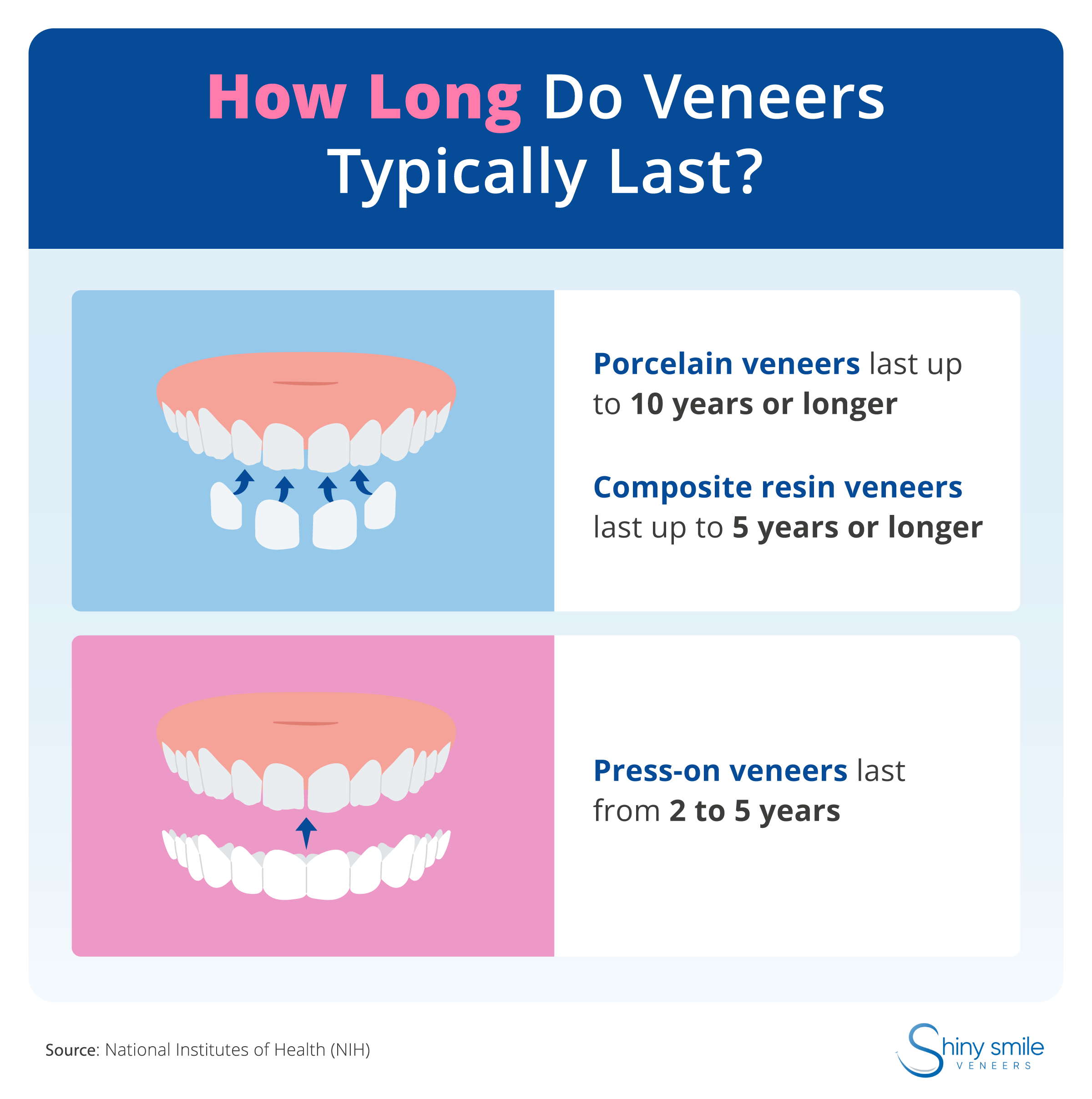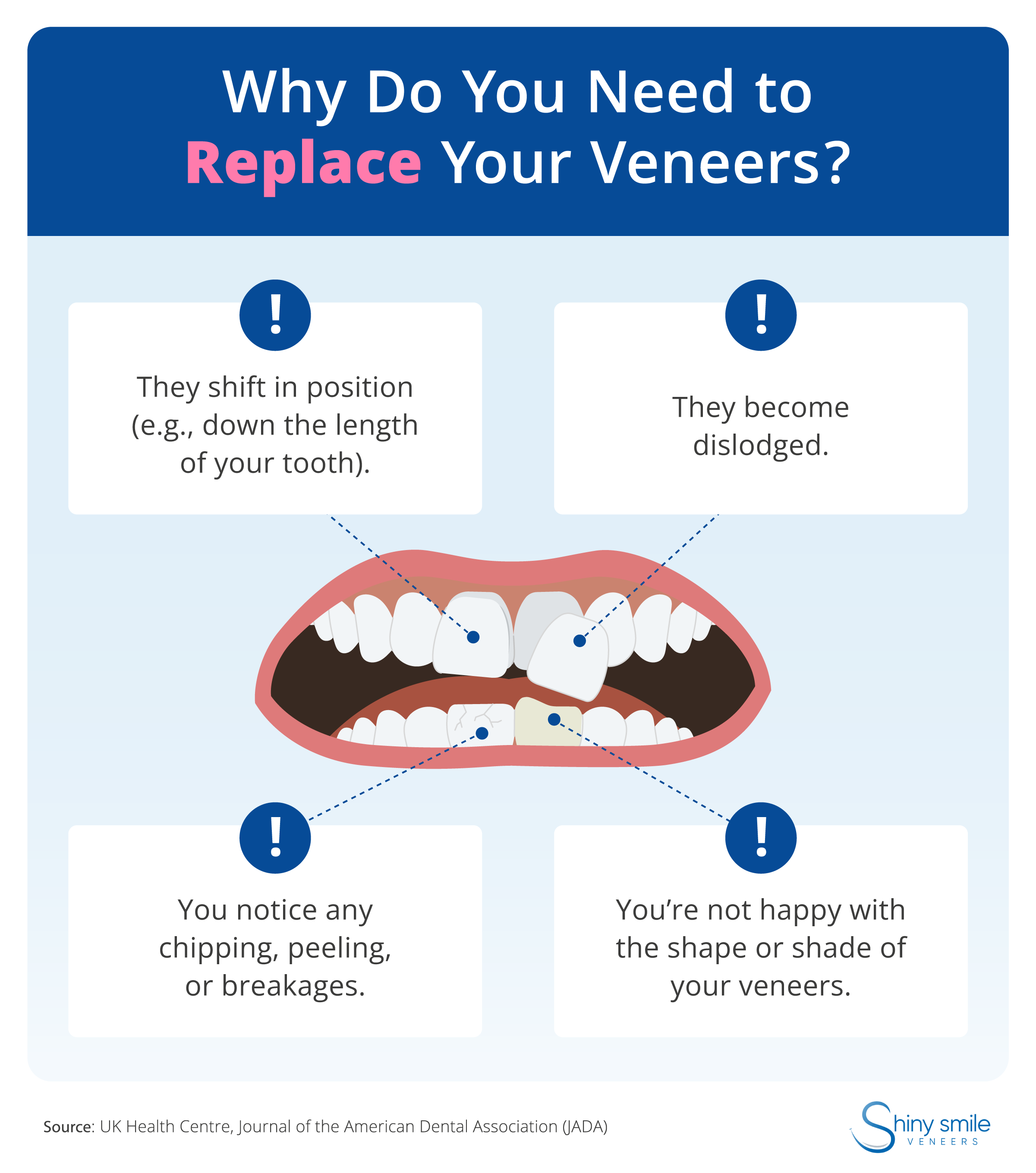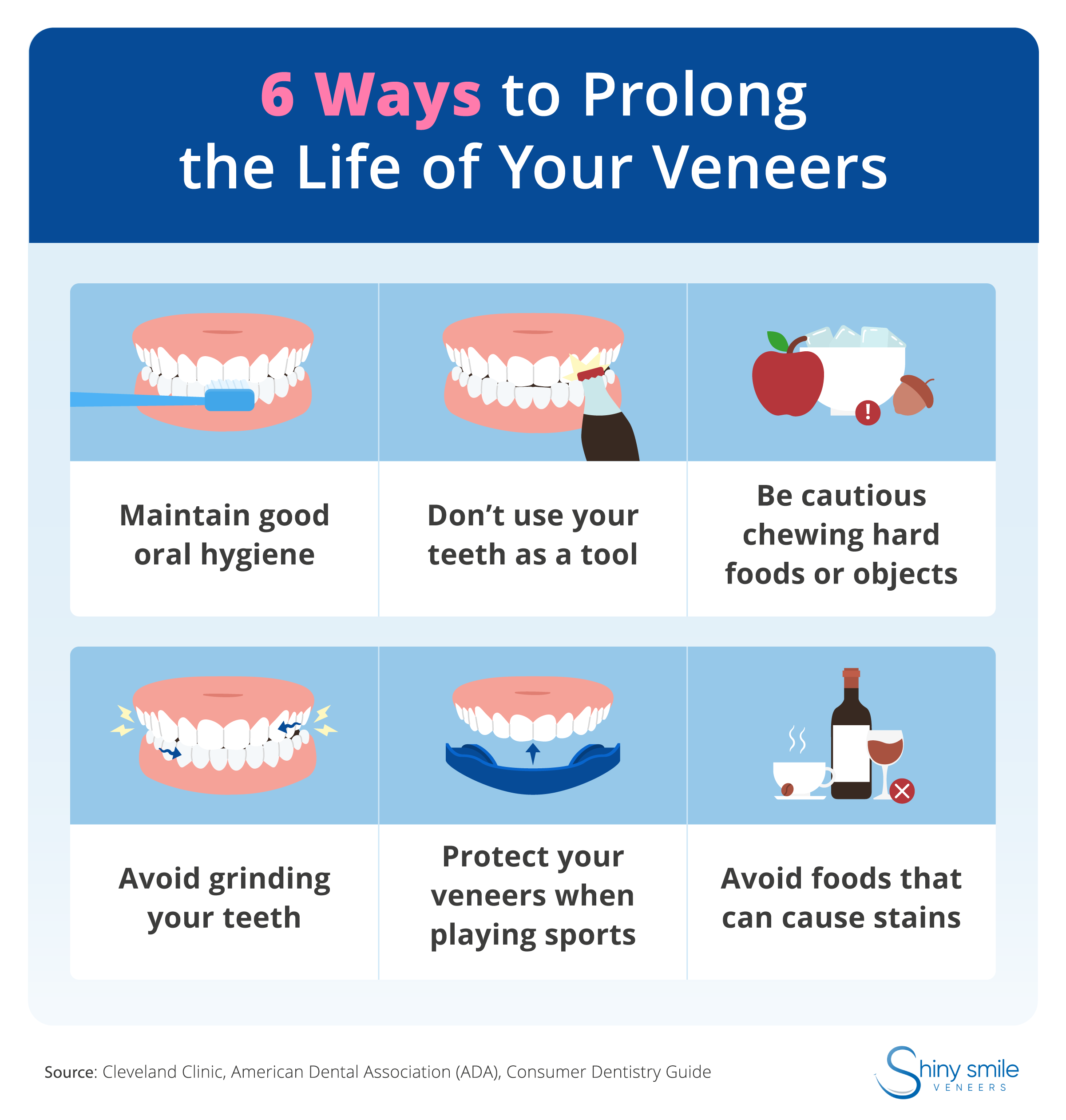
Dental veneers are a cosmetic dentistry procedure designed to conceal tooth cracks, chips, stains, and other imperfections. Although the process of getting veneers is often permanent, how long the veneers last depends on the type and material. Composite veneers typically last up to 5 years, while those made of porcelain can last 10 years or longer with proper care. In this post, we explain in detail the different types of dental veneers, the longevity of different materials, and how you can make your veneers last as long as possible.
Table of Contents:
- How long does each type of veneer last?
- How are dental veneers fitted to your teeth?
- When do you need to replace your veneers?
- 6 ways to prolong the life of your veneers
- Get a confident smile that lasts
How Long Does Each Type of Veneer Last?
While your dental hygiene habits can affect the lifespan of your veneers, how long veneers last depends significantly on the type and material.

Porcelain Veneers
Dentists consider porcelain veneers the most natural-looking and durable type of veneer. They look natural because porcelain has a translucent quality, much like tooth enamel. Because they also resist chipping and wear, porcelain veneers last up to 10 years or longer — with some studies showing a lifespan of 20 years.
These qualities often come with a high price tag, however, as porcelain veneers typically cost between $925 and $2,500 per tooth. Because chipped or fractured porcelain veneers cannot be repaired, you may incur additional costs to replace damaged veneers.
Composite Resin Veneers
A more affordable but less durable option, composite veneers use layers of tooth-colored resin hardened under a high-intensity light. Composite veneers typically cost between $250 and $1,500 per tooth and last up to five years or longer. Because the material is more porous and less stain resistant than porcelain, changing your diet can help you protect your new look if you avoid foods that may stain your teeth.
Press-on Veneers
Also known as clip-on veneers, snap-on veneers, and removable veneers, press-on veneers fit over your existing teeth. With normal wear, clip-on veneers last up to five years and even longer depending on how often you wear them. One of their biggest advantages is price, with Shiny Smile Veneers costing $570.
Although they don’t last as long as porcelain or composite veneers, clip-on veneers can be a smart choice if you want to save money and avoid a permanent dental procedure. Plus, they don’t require a visit to the dentist. You take an impression of your teeth using a kit at home and receive a customized set of veneers in the mail.
How Are Dental Veneers Fitted to Your Teeth?
Getting porcelain veneers is an irreversible procedure that involves removing some of your natural tooth enamel to fit thin shells over your existing teeth. You can’t go back to your normal teeth afterward, and the procedure may cause your teeth to become more sensitive to heat and cold. The process involves at least two dental appointments: one to take a mold of your teeth and another to permanently bond the veneers to the front of your teeth. It may take several weeks to make the veneers and ship them back from the laboratory.
Typically a same-day treatment, getting composite veneers is quicker and less invasive than getting porcelain veneers. Although some enamel still needs to be removed, the dentist will apply a resin directly onto your teeth, sculpt it into the proper shape, and harden it using a high-intensity light.
Unlike traditional permanent veneers, press-on veneers don’t require the removal of any tooth enamel, can be fitted yourself at home, and can be taken off whenever you like.
Why Do You Need to Replace Your Veneers?
Even though getting porcelain or composite veneers is an irreversible process, the veneers themselves will eventually need to be replaced with new ones. They can become dislodged over time and experience normal wear and tear from daily life. The following situations may require a dentist to replace your veneers.

- If you notice any chipping, peeling, or breakages, you may need a veneer replacement.
- If your veneers shift from their original position, it may mean the dentist did not fit them correctly. As veneers move down the length of the tooth, they can create a dark line just below your gum line. Your dentist can fix this issue by reapplying the veneers.
- If you’re dissatisfied with the appearance of your new veneers (for example, they’re too large or the wrong shade), discuss your options with your dentist. Always communicate with your dentist, such as asking to see photos of their previous work, and consider carefully before committing to getting traditional veneers since they are not reversible.
6 Ways to Prolong the Life of Your Veneers
Typically, dental care practices that promote good oral health can also prolong the life of your veneers.

Maintain Good Oral Hygiene
Because traditional veneers cover just the front surface of your teeth, the natural structure underneath can still get cavities. To prevent tooth decay and gum disease, practice good oral hygiene and care for veneers like you would your original teeth. For example, brush with a soft-bristled toothbrush and nonabrasive fluoride toothpaste at least twice a day, floss between your teeth daily, and use antibacterial mouthwash twice a day. Also remember to visit your dentist for regular check-ups and cleanings.
Don’t Use Your Teeth as a Tool
While you may sometimes find it tempting, never use your teeth as tools to open packaging, bite tags off clothing, or anything of that sort. In addition to potentially hurting your gums or mouth, you also risk cracking or chipping your teeth. To keep your veneers looking great as long as possible, also try to avoid biting your fingernails.
Be Cautious Chewing Hard Foods or Objects
Your dentist may suggest you avoid certain foods to protect your new smile. Be cautious about chewing on ice, as well as hard foods like nuts, bones, and carrots because they may damage your veneers. It’s also important to avoid chewing on hard objects, such as pencils or pen caps.
Avoid Grinding Your Teeth
Grinding your teeth can accelerate the wear and tear on both veneers and natural teeth. If you have bruxism (a condition that causes you to clench your jaw or grind your teeth unconsciously) your dentist may recommend that you wear a protective night guard while sleeping to prevent damaging your veneers.
Protect Your Veneers When Playing Sports
When playing contact sports, wearing a mouthguard can protect your veneers from chipping or breaking during a collision. As recommended by the American Dental Association (ADA) to reduce the risk of experiencing dental trauma, anyone playing sports or participating in active recreational activities should wear a mouthguard that fits properly.
Avoid Foods That Can Cause Stains
To preserve the appearance of your veneers, you may wish to avoid color-saturated foods and drinks that could cause veneers to stain. This may include items like curry, pasta sauce, berries, balsamic vinegar, coffee, tea, and red wine. Brushing your teeth after consuming these foods and beverages may help, as can rinsing your mouth with water if you’re not able to brush. Avoiding stain-causing foods may be particularly important if you have composite veneers since porcelain tends to resist stains better.
Get a Confident Smile That Lasts
For a smile makeover that lasts, porcelain is your most durable option. With a potential lifespan of ten years or more, porcelain veneers also come with a substantial price tag to match. Composite resin veneers make a more affordable but less durable choice. Since the dentist will bond traditional veneers to your teeth, both of these treatments are irreversible.
To evaluate the best decision for you, compare how long each type of veneer lasts, how much it costs, and the potential downsides to any procedure. If you’re looking for an alternative to permanent veneers, snap-on Shiny Smile Veneers can give you a new smile without visiting the dentist or breaking the bank.
